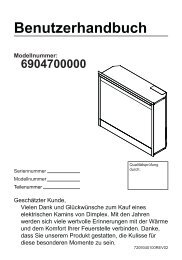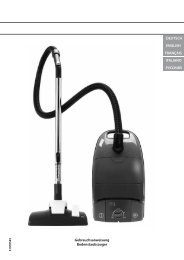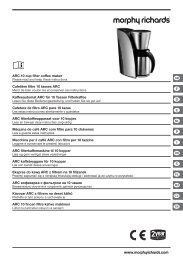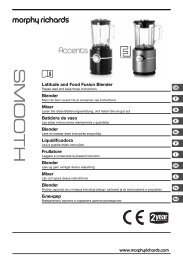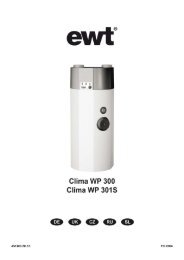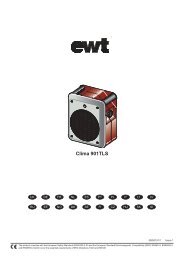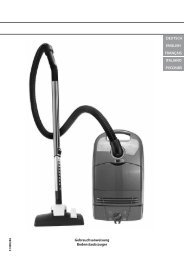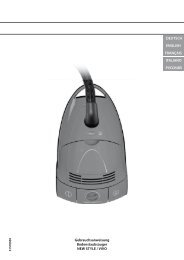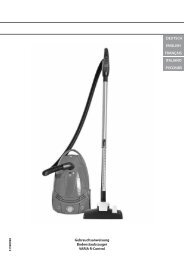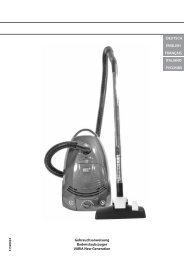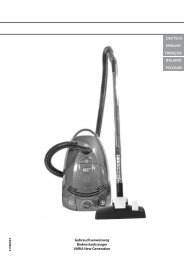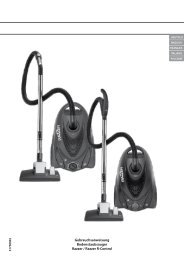9094 48960MEE Multitool ib ml - EWT
9094 48960MEE Multitool ib ml - EWT
9094 48960MEE Multitool ib ml - EWT
Create successful ePaper yourself
Turn your PDF publications into a flip-book with our unique Google optimized e-Paper software.
Homemade Programmes<br />
There are 2 home made programmes (No.18 & No.19) which allow you to adapt an<br />
existing baking programme to your own specific requirements. For example you may want<br />
to follow the wholemeal programme (No. 2) but prefer a denser texture. You can achieve<br />
this by using the Home made programmes. You have the opportunity to change the timings<br />
of each stage of the process from between zero minutes to 2 hours depending on the<br />
stage. Note, when zero minutes are selected, that stage of the cycle will not be part of the<br />
baking programme.<br />
Knead 1<br />
When you scroll to programme 18 or 19 the ‘knead 1’ symbol automatically flashes on<br />
screen with 10 minutes showing on the clock. The knead 1 cycle length can be increased<br />
or decreased to between 6-14 minutes by pressing ‘+’ or ‘-‘ Ó, Ô. Confirm the length of<br />
the 1st knead cycle by pressing the green tick button apple and the Rise 1 symbol will start<br />
flashing.<br />
Rise 1<br />
20 minutes appears on the clock as the default time for this stage of the process.<br />
The Rise 1 cycle length can be increased or decreased to between 20-60 minutes by<br />
pressing ‘+’ or ‘-‘ Ó, Ô. Confirm the time you want by pressing the green tick button<br />
and the Knead 2 symbol will flash on the screen.<br />
Knead 2<br />
15 minutes appears on the clock as the default time for this stage of the process. The<br />
length of the 2nd knead cycle can be increased or decreased to between 5-20 minutes by<br />
pressing ‘+’ or ‘-‘ Ó, Ô. Confirm the length of the 2nd knead cycle by pressing the<br />
green tick button and the Rise 2 symbol will flash on the screen.<br />
Rise 2<br />
25 minutes appears on the clock as the default time for this stage of the process.<br />
The length of the 2nd Rise cycle can be increased or decreased to between 5 – 120<br />
minutes by pressing ‘+’ or ‘-‘ Ó, Ô. Confirm the time you want by pressing the green<br />
tick button and the Rise 3 symbol will flash on the screen.<br />
Rise 3<br />
45 minutes appears on the clock as the default time for this stage of the process. The<br />
length of the 3rd Rise cycle can be increased or decreased by between 2 – 120 minutes by<br />
pressing ‘+’ or ‘-‘ Ó, Ô. Confirm the time you want by pressing the green tick button<br />
and the Bake symbol will flash on the screen.<br />
Bake<br />
35 minutes appears on the clock as the default time for this stage of the process.<br />
The length of the Baking cycle can be increased or decreased between 0 –1 hour and 20<br />
minutes by pressing ‘+’ or ‘-‘ Ó, Ô. Confirm the time you want by pressing the green<br />
tick button and the Crust Control symbol will flash on the screen.<br />
Crust Setting<br />
At this stage the clock disappears from the screen.<br />
Very Light<br />
Light<br />
Medium<br />
Dark<br />
Very Dark<br />
There are 5 different crust settings you can choose.<br />
Scroll to select the crust colour you want and press green tick button to confirm and the<br />
total cooking time programmed, appears on the screen. You can either start the<br />
programme baking immediately by pressing the green tick button for 3 seconds apple or use<br />
the Delay Timer function.<br />
Slicing and Storing Bread<br />
For best results place bread on a wire rack and allow to cool for 15-30 minutes before<br />
slicing.<br />
Use an electric knife or a sharp knife with a serrated blade for even slices.<br />
Store unused bread tightly covered in a plastic bag at room temperature for up to three days.<br />
If weather is hot and humid, store in the refrigerator overnight.<br />
For longer storage (up to one month), place bread in a tightly covered container in the<br />
freezer.<br />
If you store the bread in the refrigerator, leave it out to bring it to room temperature before<br />
serving.<br />
Since homemade bread has no preservatives it tends to dry out and become stale faster<br />
than commercially made bread.<br />
Leftover slightly hardened bread may be cut into 1.3 cm (half inch) or 2.5cm (1 inch) cubes<br />
and used in favourite recipes to make croutons, bread pudding, or stuffing.<br />
Care and Cleaning<br />
1 Caution: To prevent electrical shock, unplug the unit before cleaning.<br />
2 Wait until the breadmaker has cooled.<br />
• IMPORTANT: Do not immerse or splash either the body or lid in any liquid as this may<br />
cause damage and/or electric shock.<br />
3 Exterior: Wipe the lid and outer body of the unit with a damp cloth or slightly dampened<br />
sponge.<br />
4 Interior: Use a damp cloth or sponge to wipe the interior of the breadmaker.<br />
5 Baking pan: Clean the baking pan with warm water, soap is not necessary. Avoid scratching<br />
the non-stick surface. Dry it thoroughly before placing it back in the baking chamber.<br />
6 Fruit and nut dispenser: The dispenser is removed by lifting the right side first. Once the<br />
right side has been lifted, the whole dispenser may be removed. The dispenser should be<br />
cleaned using warm soapy water and a damp cloth/sponge. It should then be rinsed<br />
thoroughly and left to dry naturally. To replace the dispenser, ensure the left side is slotted<br />
in to place first. The right side can then be pushed down, back in to position.<br />
• Do not wash the baking pan, measuring cup, spoon or kneading blades in the dishwasher.<br />
• Do not soak the baking pan for long periods as this could interfere with the working of the<br />
drive shaft.<br />
• If the paddle becomes stuck in the bread pan, pour hot water over it and allow to soak for<br />
30 minutes. This will enable you to remove the paddle more easily.<br />
• Be sure the appliance is completely cooled before storing away.<br />
Do not use Steel wool pads when cleaning.<br />
Special care for the non-stick finish. Avoid damaging the coating. Do not use metal<br />
utensils such as spatulas, knives or forks. The coating may change colour after long use,<br />
this is only caused by moisture and steam and will not affect the performance of the unit or<br />
quality of your bread.<br />
Ensure that the whole kneading blade which the shaft fits in to is cleaned thoroughly after<br />
use. After cleaning, add a drop of cooking oil to the hole before returning the blade to the<br />
shaft. This will help prevent the blade from sticking.<br />
• Keep all air vents and openings clear of dust.<br />
Storing the Unit<br />
Be sure to dry all parts before storing including wiping any moisture from the viewing<br />
window. Close the lid and do not store anything on top of the lid.<br />
Getting Successful Results<br />
1 Place all recipe ingredients into the baking pan so that yeast is not touching any liquid.<br />
2 If you are using the machine on the Dough setting (programme 6), after the cycle is<br />
complete, remove the dough from the breadmaker, cover in a thin coating of sunflower oil<br />
and cover with greaseproof paper and a dry tea towel. The dough should then be left in a<br />
warm area free from draughts, for approximately 30 minutes or until it has roughly doubled<br />
in size.<br />
3 Humidity can cause problems, therefore humidity and high altitudes require adjustments.<br />
For high humidity, add an extra tablespoon of flour if consistency is not right. For high<br />
altitudes, decrease yeast amount by approximately ¼ teaspoon, and decrease sugar and/or<br />
water or milk slightly.<br />
4 The DOUGH setting is great for the mixing, kneading and proofing (allowing dough to rise)<br />
of richer doughs like croissant dough. Use the breadmaker to prepare this dough so all you<br />
need to do is shape and bake it according to your recipe.<br />
5 When recipes call for a ‘lightly floured surface,’ use about 1 to 2 tablespoons of flour on the<br />
surface. You may want to lightly flour your fingers or rolling pin for easy dough<br />
manipulation.<br />
6 When you let dough ‘rest’ and ‘rise’ according to a recipe, place it in a warm, draught-free<br />
area. If the dough does not double in size, it may not produce a tender product.<br />
7 If the dough you are rolling shrinks back, let it rest covered for a few minutes before rolling<br />
again.<br />
8 Dough may be wrapped in plastic and stored in a freezer for later use. Bring the dough to<br />
room temperature before using.<br />
9 After 5 minutes of kneading, open the lid and check the dough consistency. The dough<br />
should form a soft, smooth ball. If too dry, add liquid. If too wet, add flour (½ to 1<br />
tablespoon at a time).<br />
Measuring ingredients<br />
The key and most important step when using your breadmaker is measuring your<br />
ingredients precisely and accurately. It is extremely important to measure each liquid and<br />
dry ingredient properly or it could result in a poor or unacceptable baking result. Do not use<br />
normal kitchen teaspoons or tablespoons. The ingredients must also be added into the<br />
baking pan in the order in which they are given in each recipe. Liquid and dry ingredients<br />
should be measured as follows:<br />
Measuring cup<br />
The cup is marked in various ‘volume measurement’ scales. The recipes in this book use<br />
the ‘cup’ volume which is based on the ‘American’ cup of 8 floz and is conveniently marked<br />
in ¹/16 divisions.<br />
• If you prefer to use weight (gms) as a measurement, fill and weigh the required number of<br />
cups and record this conversion.<br />
ie: 2 cups = xx gms<br />
3 cups = xxx gms<br />
You must use a good quality set of accurate scales, we prefer to use the ‘cup’ measure for<br />
consistency and accuracy.<br />
Liquid measurements<br />
Use the cups provided B. When reading amounts, the measuring cup must be placed on a<br />
horizontal flat surface and viewed at eye level (not on an angle). The liquid level line must<br />
be aligned to the mark of measurement.<br />
A ‘guesstimate’ is not good enough as it could throw out the critical balance of the recipe.<br />
Dry measurements<br />
Dry measurements (especially flours) must be done using the measuring cups provided.<br />
The measuring cups are based on the American standard 8 fluid oz cup - British cup is 10<br />
fluid oz. Dry measuring must be done by gently spooning ingredients into the measuring<br />
cup and then once filled, levelling off with a knife C. Scooping or tapping a measuring cup<br />
will pack the ingredients and you will end up with more than is required. This extra amount<br />
could affect the balance of the recipe. Do not sift the flour, unless stated.<br />
When measuring small amounts of dry or liquid ingredients (ie yeast, sugar, salt, powdered<br />
milk, honey, molasses) the small measuring spoon which is provided must be used.<br />
Measurements must be level, not heaped as this small difference could throw out the<br />
critical balance of the recipe D.<br />
Your breadmaker produces delicious baked goods with ease. This machine requires only that<br />
you carefully follow the recipe instructions. In basic cooking, normally ‘a pinch of this and a<br />
dash of that’ is fine, but not for breadmakers. Using an automatic breadmaker requires you<br />
accurately measure each ingredient for best results.<br />
• Always add ingredients in the order they are listed in the recipe.<br />
• Accurate measuring of ingredients is vital. Do not use larger amounts.<br />
Understanding baking<br />
It is often said that cooking is an art relying on the creativity of the chef, while baking bread<br />
is much more of a science. This means that the process of combining flour, water and yeast,<br />
results in a reaction that produces bread. You have to remember that when the ingredients<br />
combine with each other they produce a specific result. Read the following information<br />
carefully to gain a better understanding of the importance each ingredient plays in the<br />
breadmaking process.<br />
Using the right Flour<br />
Flours, while vis<strong>ib</strong>ly similar, can be very different by virtue of how they were grown, milled,<br />
stored, etc. You may find that you will have to experiment with different brands of flour to<br />
help you make that perfect loaf. Storage is also very important, as all flours should be kept in<br />
an airtight container.<br />
All purpose flour/plain flour<br />
All purpose flour is a blend of refined hard and soft wheat flours especially suitable for<br />
making cake.<br />
This type of flour should be used for recipes in the cake/quick bread section.<br />
Strong white flour/bread flour<br />
Bread flour is a high gluten/protein flour that has been treated with conditioners that give<br />
dough a greater suitability for kneading. Bread flour typically has a higher gluten<br />
concentration than All purpose flour; however, depending on different milling practices, this<br />
may vary. Strong plain flour or bread flour are recommended for use with this breadmaker.<br />
Wholewheat flour/ wholemeal flour<br />
Wholewheat flour/wholemeal flour is milled from the entire wheat kernel which contains the<br />
bran and germ and makes it heavier and richer in nutrients than white flour. Breads made<br />
with this flour are usually smaller and heavier than white loaves. To overcome this<br />
wholewheat flour/wholemeal flour can be mixed with Bread flour or strong plain flour to<br />
produce a lighter textured bread.<br />
Self-raising flour<br />
Self-raising Flour contains unnecessary leavening ingredients that will interfere with bread<br />
and cake making. It is not recommended for use.<br />
Bran<br />
Bran (unprocessed) & Wheat Germ are the coarse outer portions of the wheat or rye grains<br />
separated from flour by sifting or bolting. They are often added in small quantities to bread<br />
for nutritional enrichment, heartiness and flavour. They are also used to enhance the texture<br />
of bread.<br />
Oatmeal<br />
Oatmeal comes from rolled or steel-cut oats. They are used primarily to enhance flavour and<br />
texture.<br />
Other Ingredients<br />
Yeasts (active dry yeast)<br />
Yeast through a fermentation process produces gas (carbon dioxide) necessary to make<br />
the bread rise. Yeast must be able to feed on sugar and flour carbohydrates in order to<br />
produce this gas. Fast action granular yeast is used in all recipes that call for yeast. There<br />
are three different types of yeast available: fresh, traditional dry active, and fast action. It is<br />
recommended that fast action yeast be used. Fresh or compressed cake yeast is not<br />
recommended as they will produce poor results. Store yeast according to manufacturers<br />
instructions. Ensure your yeast is fresh by checking its expiration date. Once a package or<br />
can of yeast is opened it is important that the remaining contents be immediately resealed<br />
and refrigerated as soon as poss<strong>ib</strong>le for future use. Often bread or dough, which fails to<br />
rise is due to stale yeast being used. The following test can be used to determine whether<br />
your yeast is stale and inactive:<br />
1 Place half a cup of lukewarm water into a small bowl or cup.<br />
2 Stir 1 tsp. of sugar into the water then sprinkle 2 tsp. of yeast over the surface.<br />
3 Place bowl or cup in a warm area and allow to sit for 10 minutes undisturbed.<br />
4 The mixture should foam and produce a strong yeast aroma. If this does not occur,<br />
discard mixture and start again with another packet of dried yeast.<br />
Sugar<br />
Sugar is important for the colour and flavour of breads. It is also food for the yeast as it is<br />
part of the fermentation process. Artificial sweeteners cannot be used as a substitute for<br />
sugar as the yeast will not react properly with them.<br />
Salt<br />
Salt is necessary to balance the flavour of breads and cakes, as well as for the crust colour<br />
that develops during baking. Salt also limits the growth of yeast so the amounts shown in<br />
the recipes should not be increased. For dietary reasons it may be reduced, however, your<br />
baking may suffer.<br />
Liquids/milk<br />
Liquids such as milk or a combination of powdered milk and water, can be used when<br />
making bread. Milk will improve flavour, provide a velvety texture and soften the crust,<br />
while water alone will produce a crispier crust. Some liquids call for juice (orange, apple,<br />
etc) to be added as a flavour enhancer. Note: For most recipes we suggest the use of dry<br />
(powdered) skimmed milk.<br />
Eggs<br />
Eggs add richness and a velvety texture to bread doughs and cakes.<br />
Sunflower oil<br />
‘Shortens’ or tenderises the texture of yeast breads. Butter or margarine can be used as a<br />
substitute. If butter or margarine is used direct from the refrigerator it should be softened<br />
first for easier blending during the mixing cycle.<br />
Baking powder<br />
Baking powder is a raising agent used in cakes. This type of raising agent does not require<br />
rising time before baking as the chemical reaction works when liquid ingredients are added.<br />
Bicarbonate of soda<br />
Bicarbonate of soda is another raising agent not to be confused or substituted for baking<br />
powder. It also does not require rising time before baking as the chemical reaction works<br />
during the baking process.<br />
Bread Mixes<br />
Use the Bread mix’ setting. (programme 8)<br />
Follow the information for bread mixes on the bread mix packet. There are two types of<br />
bread mixes currently available.<br />
1 Just add water.<br />
These mixes are complete and they have all the necessary ingredients provided, even the<br />
yeast. You only add water.<br />
• IMPORTANT: Follow the packet instructions as some mixes contain more than the normal<br />
amount of yeast, which could over rise in the pan. Use 3 cups of mix maximum.<br />
• These mixes are more prone to over-rising and collapsing when the weather is hot and<br />
humid. Since these mixes are complete, we cannot advise how to adjust, as with our own<br />
recipes. Bake in the coolest part of the day, use water between 21-28°C.<br />
2 Just add flour and water<br />
These mixes have the necessary ingredients in separate sachets.<br />
Remember strong white bread flour is required. A packet of this mix will produce a 700g<br />
loaf, just over 1.5lb.<br />
12 13<br />
g



